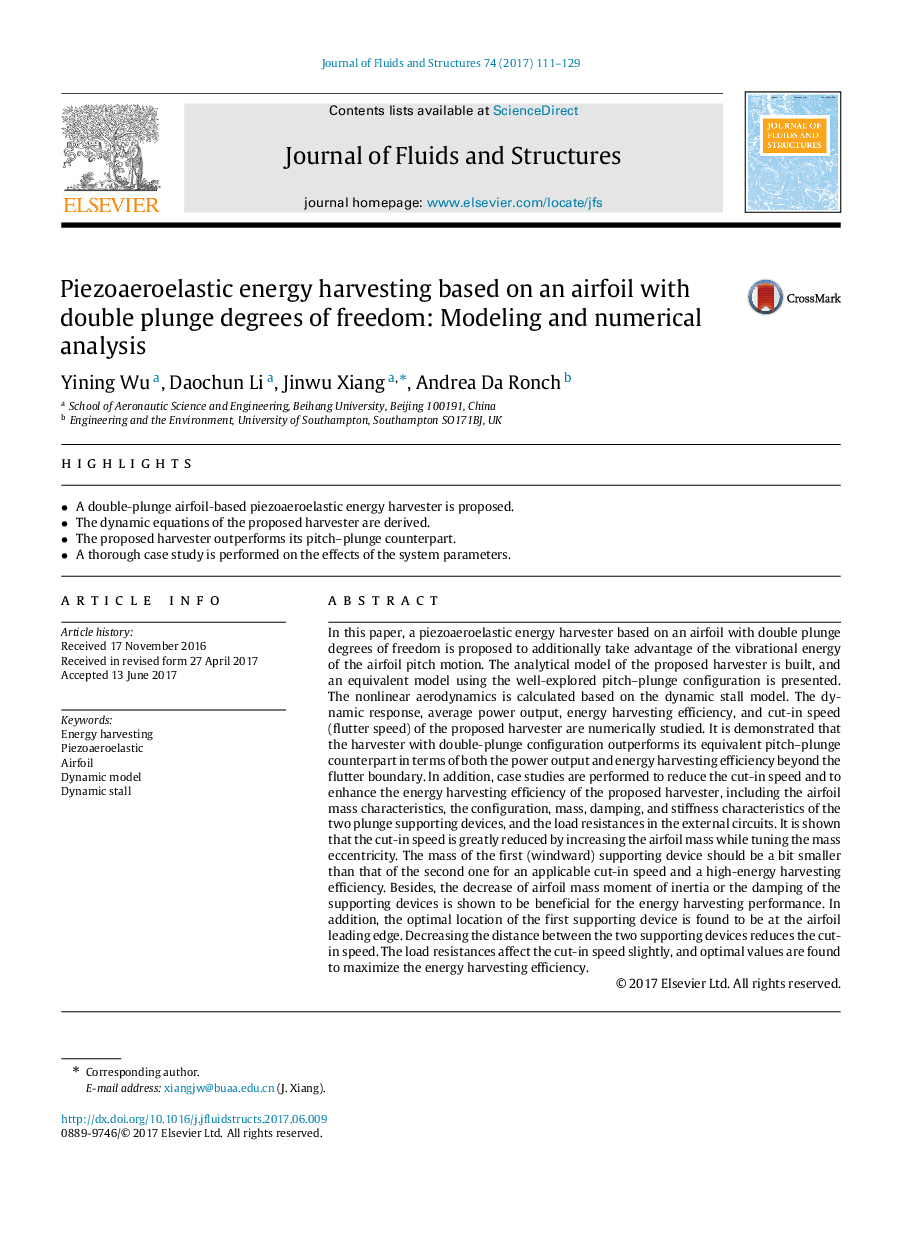| کد مقاله | کد نشریه | سال انتشار | مقاله انگلیسی | نسخه تمام متن |
|---|---|---|---|---|
| 5017389 | 1466573 | 2017 | 19 صفحه PDF | دانلود رایگان |
عنوان انگلیسی مقاله ISI
Piezoaeroelastic energy harvesting based on an airfoil with double plunge degrees of freedom: Modeling and numerical analysis
ترجمه فارسی عنوان
برداشتن انرژی پیزوئورالاستفاده بر اساس یک فروند هواپیما با درجه دو برابر شدن آزادی: مدلسازی و تحلیل عددی
دانلود مقاله + سفارش ترجمه
دانلود مقاله ISI انگلیسی
رایگان برای ایرانیان
کلمات کلیدی
ترجمه چکیده
در این مقاله، یک ارزیاب انرژی پیزوالئولاستیک مبتنی بر هوافول با درجه دو درجه آزادگی پیشنهاد شده است که علاوه بر استفاده از انرژی ارتعاشی حرکت حرارتی هوافیلم، پیشنهاد می شود. مدل تحلیلی برداشت محصول پیشنهادی ساخته شده است و مدل معادل آن با استفاده از پیکربندی پیچش دقیق مورد بررسی قرار گرفته است. آیرودینامیکی غیرخطی بر اساس مدل پویای پویا محاسبه شده است. پاسخ دینامیکی، متوسط قدرت خروجی، بهره وری انرژی برداشت و سرعت برش (سرعت شیب دار) برداشت محصول پیشنهادی مورد بررسی قرار گرفته است. نشان داده شده است که برداشت محصول با پیکربندی دوگانه در مقایسه با میزان بهره وری انرژی از حد مجاز فراتر از مقیاس همجواری مقیاس قیمتی خود، از لحاظ عملکرد و خروجی انرژی است. علاوه بر این، مطالعات موردی برای کاهش سرعت برش و افزایش بهره وری برداشت انرژی برداشت محصول پیشنهادی، از جمله مشخصات جرم هواپیما، پیکربندی، جرم، محاسبه و ویژگی های سختی دو دستگاه پشتیبانی از شیر آب انجام می شود و مقاومت بار در مدارهای خارجی. نشان داده شده است که سرعت برش را با افزایش تراکم آئروپویل کاهش می دهد در حالی که تنظیم غلتک توده. جرم اولین دستگاه پشتیبانی (باد) باید کمی کوچکتر از سرعت دوم برای سرعت برش قابل استفاده باشد و کارایی برداشتن انرژی بالا باشد. علاوه بر این، کاهش لحظه ای جرم هواپیما از نفوذ یا مخلوط کردن دستگاه های پشتیبانی شده نشان می دهد که برای عملکرد برداشت انرژی مفید است. علاوه بر این، موقعیت مطلوب اولین دستگاه پشتیبانی کننده در لبه پیشانی هواپیما قرار دارد. کاهش فاصله بین دو دستگاه پشتیبانی می کند سرعت برش را کاهش می دهد. مقاومت در برابر بار بر روی سرعت برش کمی تاثیر می گذارد و مقادیر بهینه برای بهره وری برداشت انرژی به حداکثر می رسند.
موضوعات مرتبط
مهندسی و علوم پایه
سایر رشته های مهندسی
مهندسی مکانیک
چکیده انگلیسی
In this paper, a piezoaeroelastic energy harvester based on an airfoil with double plunge degrees of freedom is proposed to additionally take advantage of the vibrational energy of the airfoil pitch motion. The analytical model of the proposed harvester is built, and an equivalent model using the well-explored pitch-plunge configuration is presented. The nonlinear aerodynamics is calculated based on the dynamic stall model. The dynamic response, average power output, energy harvesting efficiency, and cut-in speed (flutter speed) of the proposed harvester are numerically studied. It is demonstrated that the harvester with double-plunge configuration outperforms its equivalent pitch-plunge counterpart in terms of both the power output and energy harvesting efficiency beyond the flutter boundary. In addition, case studies are performed to reduce the cut-in speed and to enhance the energy harvesting efficiency of the proposed harvester, including the airfoil mass characteristics, the configuration, mass, damping, and stiffness characteristics of the two plunge supporting devices, and the load resistances in the external circuits. It is shown that the cut-in speed is greatly reduced by increasing the airfoil mass while tuning the mass eccentricity. The mass of the first (windward) supporting device should be a bit smaller than that of the second one for an applicable cut-in speed and a high-energy harvesting efficiency. Besides, the decrease of airfoil mass moment of inertia or the damping of the supporting devices is shown to be beneficial for the energy harvesting performance. In addition, the optimal location of the first supporting device is found to be at the airfoil leading edge. Decreasing the distance between the two supporting devices reduces the cut-in speed. The load resistances affect the cut-in speed slightly, and optimal values are found to maximize the energy harvesting efficiency.
ناشر
Database: Elsevier - ScienceDirect (ساینس دایرکت)
Journal: Journal of Fluids and Structures - Volume 74, October 2017, Pages 111-129
Journal: Journal of Fluids and Structures - Volume 74, October 2017, Pages 111-129
نویسندگان
Yining Wu, Daochun Li, Jinwu Xiang, Andrea Da Ronch,
